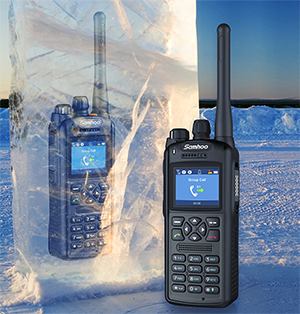 As an open standard, the digital trunking communications standard for digital mobile radio (DMR) is designed and formulated by ETSI to target low-end and mid-range specialized and commercial users in Europe. It emerged in April 2005 as a standard for digital mobile wireless communications. The latest version became available in December 2007.
As an open standard, the digital trunking communications standard for digital mobile radio (DMR) is designed and formulated by ETSI to target low-end and mid-range specialized and commercial users in Europe. It emerged in April 2005 as a standard for digital mobile wireless communications. The latest version became available in December 2007.1. Market Positioning (Applicable Industries)
The DMR standard is designed for low-end and mid–range specialized and commercial users in sectors such as public utilities, schools, hospitals, hotels, and real estate.
2. Main Features
Operating in operates in the TDMA (double time slots) multiple address mode, the DMR standard provides a channel interval of 12.5 kHz, 4-FSK modulation, and a data transmission rate of 9.6 KB/s. This standard is evolving in three stages: a digital standard for free frequency bands, conventional digital technology and trunking technology.
The DMR standard can fully utilize spectrum resources. Working in macro cell networking mode, the technology supports smooth evolution from analog MPT1327 to digital trunking. The standard provides a wide range of services, strong scalability and backward compatibility. Mover, the technology allows for low-cost systems and terminals and supports swift network construction and cost-effective operation and maintenance (O&M).
http://dmrassociation.org/
 Formerly known as Trans European Trunked Radio, TETRA is currently referred to as Terrestrial Trunked Radio. Formulated by European Telecommunications Standards Institute (ETSI), the open standard is designed to meet the requirements of specialized sectors in European countries on mobile communications. Available for use in 1988, it has become a European standard.
Formerly known as Trans European Trunked Radio, TETRA is currently referred to as Terrestrial Trunked Radio. Formulated by European Telecommunications Standards Institute (ETSI), the open standard is designed to meet the requirements of specialized sectors in European countries on mobile communications. Available for use in 1988, it has become a European standard.
1. Market Positioning (Applicable Industries)
The TETRA Standard targets users in industries such as emergency communications, government and public security, transportation, and public utilities.
2. Global Distribution
The TETRA Standard is mainly used in Europe. According to latest statistics from TETRA MoU, the Standard has been accepted by 117 countries and regions, except for North America.
3. Technologies and Applications
Based on the 4-time slot time division multiple address (TDMA) technology, the TETRA I standard features a 25 kHz channel internal and a data transmission rate of up to 36 KB/s, and provides a rich set of functions. The TETRA Standard has entered the second stage of development. In the first stage, the Tetra I Standard focuses on voice services and the technology is mature. In the second stage, Tetra II (TETRA enhanced data service (TEDS)) extends reach to high-speed data services. Motorola and Sepura launched a prototype in 2010.
The TETRA digital trunking communications system can provide command and dispatching, data transmission, and telephony services on the same platform. In addition to multi-group dispatching, the system delivers short data information, group data, and digital full-duplex mobile call services. The system also supports powerful direct mode operation (DMO) for mobile stations to provide capabilities such as authentication, air interface and end-to-end encryption. The trunking system includes virtual private networking capabilities to serve a number of independent organizations over one physical network. This system supports a wide range of new applications, such as vehicle positioning, image transmission, mobile internet, and database inquiry.
Operating on cells, the TETRA system is suitable for users that are exposed to high terminal density and complex dispatching, and require powerful data services.
http://www.tetramou.com
 A homegrown trunking communications standard in China, PDT provides a future-oriented digital two-way radio technology to serve the needs of most users in the trunking communications industry. The PDT standard has drawn upon advanced technologies worldwide, such as Tetra, P25, DMR, and MPT1327, and provides an innovative design. The standard incorporates features, such as high performance ratio, security, macro cell, scalability and backward compatibility to combine capabilities of disparate emergency communications networks.
A homegrown trunking communications standard in China, PDT provides a future-oriented digital two-way radio technology to serve the needs of most users in the trunking communications industry. The PDT standard has drawn upon advanced technologies worldwide, such as Tetra, P25, DMR, and MPT1327, and provides an innovative design. The standard incorporates features, such as high performance ratio, security, macro cell, scalability and backward compatibility to combine capabilities of disparate emergency communications networks.
To date, the standard has been ratified by The Ministry of Public Security of the People’s Republic of China. In addition, the PDT alliance is active in bolstering PDT’s status as a Chinese national standard. The alliance is aiming to promote the PDT standard worldwide, making it one of the world-leading digital trunking standards. The Phase II PDT standard will focus on increasing data transmission rates and providing broadband service applications.
1. Market Positioning (Applicable Industries)
The PDT standard is suitable for sectors, such as public security, emergency communications and public utilities.
2. Main Features
The PDT standard operates in the TDMA (double time slots) multiple address mode and supports 12.5 kHz channel interval, 4-frequency shift keying (FSK) modulation, and a data transmission rate of up to 9.6 KB/s. In addition to basic services, the standard integrates a range of innovative functions, such as simulcasting and dynamic frequency resource management. The Phase II PDT standard will focus on increasing data transmission rates and providing broadband service applications.
Oriented to China's police market, the PDT standard addresses varied user and network construction requirements at county, municipal, provincial and national levels. In addition to supporting low-cost system communications over a single base station, the standard delivers efficient macro-cell coverage to suit the construction of a nationwide 4-level emergency communications network for public security use. The technology provides rapid access to the existing police-intended global information system (GIS) dispatching platform in response to emergencies, such as earthquakes, typhoons, and public security incidents. It features flexible networking, efficient commanding and dispatching, and high quality voice and data transmission to deliver rapid responses and a high security level.
The PDT standard can fully utilize spectrum resources. Working in macro cell networking mode, the technology supports smooth evolution from analog MPT1327 to digital trunking. The standard provides a wide range of services, strong scalability and backward compatibility. Mover, the technology allows for low-cost systems and terminals and supports swift network construction and cost-effective operation and maintenance (O&M). Overall, the PDT standard is highly competitive in the field of wireless communications. With proprietary encryption technology, the standard is ideal for the public security sector.
http://www.pdt.org.cn/html/971/





 ONLINE
ONLINE
